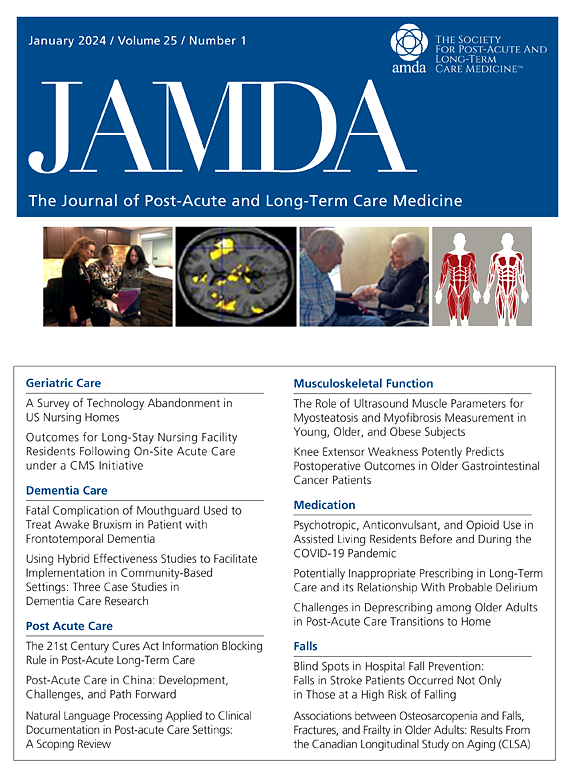Individual- and Facility-Level Factors Related to Quality-of-Life Transitions in Older Adults in Residential Facilities: A Systematic Review
IF 3.8
2区 医学
Q2 GERIATRICS & GERONTOLOGY
Journal of the American Medical Directors Association
Pub Date : 2025-07-01
DOI:10.1016/j.jamda.2025.105721
引用次数: 0
Abstract
Objectives
To elucidate factors related to the transitions of quality of life (QoL) and well-being in older adults living in residential facilities.
Design
We undertook a systematic review and narrative synthesis.
Setting and Participants
The participants were individuals aged ≥60 years living in various types of residential facilities.
Methods
We conducted a search in PubMed and Embase (Ovid) using free-text words and Medical Subject Heading terms on December 1, 2024. We included longitudinal studies published after 2000 that quantitatively assessed QoL and/or well-being at ≥2 time points. Studies published before 2000, non–English-language papers, and interventional or qualitative studies were excluded. The title, abstract, and full-text assessments were performed by multiple independent reviewers based on eligibility criteria. The Study Quality Assessment Tool for observational cohort and cross-sectional studies was used to assess methodologic quality.
Results
Of the 7705 papers initially identified, 18 studies involving 122,057 participants were included. These studies, predominantly multicenter studies and studies conducted in the United States, revealed that QoL and well-being tended to decline gradually after admission. Key factors associated with maintaining and enhancing QoL and well-being included facility-level factors (eg, age-friendly architectural environments, social support and activities) and individual aspects (eg, cognitive function, activities of daily living, urinary continence). The variation in outcome measures precluded a meta-analysis.
Conclusions and Implications
We identified both facility- and individual-level factors associated with changes related to QoL and well-being in older adults living in residential facilities. The importance of modifiable facility-level factors should be reconsidered in ensuring quality care for older residents.
与居住设施中老年人生活质量转变相关的个人和设施层面因素:一项系统综述。
目的:探讨居住在养老院的老年人生活质量和幸福感转变的相关因素。设计:我们进行了系统的回顾和叙事综合。环境和参与者:参与者是生活在不同类型的住宅设施中的60岁至60岁的个人。方法:我们于2024年12月1日在PubMed和Embase (Ovid)中使用自由文本词和医学主题标题词进行检索。我们纳入了2000年以后发表的纵向研究,在≥2个时间点定量评估生活质量和/或幸福感。2000年以前发表的研究、非英语论文以及干预性或定性研究被排除在外。标题、摘要和全文的评估由多位独立的审稿人根据资格标准进行。研究质量评估工具用于观察性队列研究和横断面研究来评估方法学质量。结果:在最初确定的7705篇论文中,纳入了18项研究,涉及122057名参与者。这些研究,主要是多中心研究和在美国进行的研究,揭示了生活质量和幸福感在入院后逐渐下降的趋势。与维持和提高生活质量和幸福感相关的关键因素包括设施层面的因素(例如,适合老年人的建筑环境、社会支持和活动)和个人方面的因素(例如,认知功能、日常生活活动、尿失禁)。结果测量的差异妨碍了meta分析。结论和意义:我们确定了与居住在养老院的老年人生活质量和幸福感变化相关的设施和个人水平因素。在确保老年居民的优质护理方面,应重新考虑可改变的设施水平因素的重要性。
本文章由计算机程序翻译,如有差异,请以英文原文为准。
求助全文
约1分钟内获得全文
求助全文
来源期刊
CiteScore
11.10
自引率
6.60%
发文量
472
审稿时长
44 days
期刊介绍:
JAMDA, the official journal of AMDA - The Society for Post-Acute and Long-Term Care Medicine, is a leading peer-reviewed publication that offers practical information and research geared towards healthcare professionals in the post-acute and long-term care fields. It is also a valuable resource for policy-makers, organizational leaders, educators, and advocates.
The journal provides essential information for various healthcare professionals such as medical directors, attending physicians, nurses, consultant pharmacists, geriatric psychiatrists, nurse practitioners, physician assistants, physical and occupational therapists, social workers, and others involved in providing, overseeing, and promoting quality

 求助内容:
求助内容: 应助结果提醒方式:
应助结果提醒方式:


